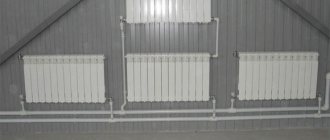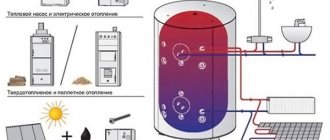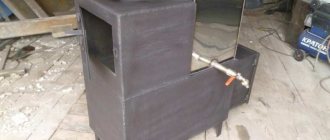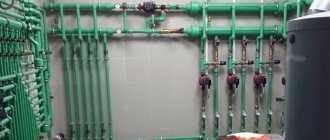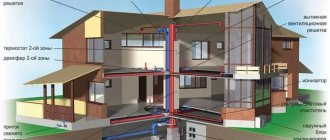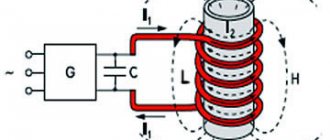A garage often performs several functions for its owner. In addition to its main purpose of storing the car from intruders and natural disasters, it also serves as a repair area and a warehouse for spare parts, fuel and lubricants, and often a resting place. If it's summer outside, there are no questions. Open the gate, turn on the carrier and repair as necessary. But if the temperature outside is very sub-zero, then you can forget about a comfortable pastime or work. And it’s worth thinking about how to build heating in a garage using antifreeze with your own hands, if no other decisions have been made.
Advantages and disadvantages of using antifreeze in a heating system
The main reason why antifreeze is poured into the garage heating system is that in this case there is no need to worry about the batteries defrosting during severe frosts. The crystallization threshold of antifreeze is much lower than that of ordinary water. Depending on the brand, it does not freeze at -20, -30 and even -40 degrees. Antifreeze, of course, may thicken somewhat, but this will have absolutely no effect on its qualities and when heated it will quickly turn into a liquid state again. At the same time, its boiling point is higher than that of water, so in this respect it is safer.
However, there are many more disadvantages, or more precisely, some inconveniences, of using antifreeze in a garage heating system installed with your own hands. It’s worth mentioning right away that these inconveniences relate rather to the process of assembling the system, during which it is necessary to observe certain safety measures and take into account the properties of this non-freezing liquid. All of them are worth listing and explaining a little:
- Viscosity. This property of antifreeze, which is much higher than that of water, requires the installation of a more powerful circular pump.
- The heat capacity, on the contrary, is much lower. That is, when the water heats up to 30 degrees, the antifreeze under the same initial conditions will only reach 20-25 degrees. And this can only be compensated for by installing additional radiators.
- Fluidity. This component is also high-grade, which means you will have to carefully check the system for cracks in order to avoid the slightest leak.
- With a long absence of circulation, in other words, stagnation of liquid, flakes can form, which, settling, can render the entire heating system unusable.
- Lifetime. Antifreeze will serve as a garage heating liquid for no more than five years. After this, you will have to drain it, thoroughly rinse the entire system and fill in a new one.
- And the main disadvantage of antifreeze is that it is poisonous. And not only the liquid itself, but also its vapor. And under the above-mentioned condition of increased fluidity, the possibility of it leaking and entering the atmosphere of the garage is very possible. If this problem is detected, you should immediately eliminate the cause of the leak, thoroughly rinse and ventilate the room.
There are many more disadvantages. However, this does not mean at all that you should forget about a garage heating system using antifreeze, installed by yourself. It’s just that all work on the installation of heat exchangers, heating radiators and pipes needs to be carried out more carefully and in compliance with all safety regulations.
Heating Requirements
You should not try to make cheap garage heating with your own hands - after all, the desire for cheapness can result in serious problems. Moreover, there are not so much cheap as economical options that will allow you to create the required temperature conditions with minimal energy costs.
When organizing heating in a garage, the following parameters must be observed:
- reliability;
- resistance to sudden changes in ambient air temperature;
- relative autonomy, allowing you to continue heating the room even when disconnected from the power supply.
It is important to fulfill the following conditions:
- ensuring maximum heat retention in the room - when insulating walls, roofs and gates, heat loss will be minimal;
- create a well-thought-out ventilation system.
Without providing thermal insulation and proper ventilation, it will not be possible to create an effective and thoughtful, economical heating system!
For a garage, a temperature of +100C is quite enough to maintain the car, start its engine without problems and guarantee normal humidity.
Heating in a garage using antifreeze - installation details
Installation of the entire heating system begins from the stove.
- Based on our preferences and capabilities, we install a heating device in the selected location. Electric or gas boiler. A stove that runs on wood, exhaust or another type of fuel.
- We hang aluminum or cast iron radiators in such a way that the heating of the entire room is uniform.
- Pipes for connecting radiators to the stove should be selected taking into account the viscosity of the antifreeze. That is, their diameter must be at least 1.5 times larger than for water heating.
- The circular pump is installed in the system at a distance of at least 1 meter from the heating device. It is recommended to install shut-off valves on both sides. This is done so that it is possible, if necessary, to remove the pump, without having to drain the antifreeze from the entire system. The pump itself should be selected so that it is twice as powerful as when used in a similar heating system operating on water.
- We install the expansion tank as high as possible. The ideal option would be to take it to the roof
- Carefully connect all elements. It is better not to use threaded connections. This is due to the increased fluidity of antifreeze, which easily seeps through such connections. But a high-quality welding seam will easily hold it.
- Filling the antifreeze system is carried out as follows:
- Approximately 2/3 of the required volume is poured into the expansion tank.
- The circulation pump turns on.
- You should drive the system a little, carefully monitoring the antifreeze level.
- Add if necessary.
- After making sure that everything is working properly, there are no leaks and the antifreeze level is appropriate, you should carefully seal the expansion tank.
- Now you can start the stove for the first time.
- During the first month or two, it is recommended to conduct a daily visual inspection of the entire system, especially the joints and connections for leaks and other faults.
When installing a heating system in a garage using antifreeze, special attention should be paid to ensuring that all elements are made of materials that are neutral to the substances contained in this non-freezing liquid. Aluminum meets these requirements, but it is quite expensive and much more difficult to install. You can use thick-walled iron pipes, especially if your system includes a homemade stove.
What to think about at the preliminary stage
Rarely lucky people are lucky enough to have a centralized heating system in their garage. This is possible if you have a shared indoor parking space or the garage is located directly in the structure of a country house.
In the remaining 99%, the stall for the iron horse is located in a garage cooperative and is a brick or metal bunker without any amenities
Therefore, the heating system must be autonomous. Before you consider purchasing a heating device, do your homework. What should be done:
- The garage needs to be insulated. Simply heating an iron bunker is literally throwing money away. Brick, metal or sandwich - all this needs additional insulation. You need to make sure that all cracks are securely caulked. It is better to place the heat insulator on the outside of the walls, but if this is not possible, the inner layer will also work. Particular attention should be paid to the floor - this is also a large area for heat loss. It should be covered with insulating material.
Don’t forget about the roof - otherwise all the heat will escape through it - It is necessary to provide high-quality ventilation. Sad statistics show that most tragic incidents in garages occur in winter. Careful insulation of the room does not allow for normal air exchange. Simply warming up the car for a few minutes before leaving can end very sadly. What can we say about the situation when the boiler is constantly running in the room.
For car boxes, it is better to use ventilation systems that combine natural and forced ventilation
Other garage heating options
For regions with frosty and long winters, antifreeze in the garage heating system is the most acceptable option. However, there are other ways.
- Water heating. The system is identical to the one described above. Only instead of antifreeze, water is poured into it. Heats up faster. Among multi-level homemade products, one of the simplest. But in case of untimely start-up, it can lead to defrosting of the pipes and complete failure.
- Air heating. Probably the only system that does not have significant drawbacks. Installation is no more difficult. Can be left indefinitely without needing to reheat.
- Electric heating. Using air heaters, air guns and other devices. Practically safe, but very expensive.
- On liquefied gas. A gas heating boiler is required, to which a propane cylinder is connected. Quite an economical option, but there is a risk of fire. It is not recommended to leave a running installation unattended.
- "Potbelly stove." A small iron stove that consumes all types of solid fuel. Fast heating, good heat dissipation. The disadvantages include the mandatory construction of a chimney and increased fire hazard.
Whatever type of heating system you install in your garage, the main thing is to understand that safety should always come first. Choose a place for the stove away from reserves of fuels and lubricants.
For car enthusiasts, a garage is a personal space for doing what you love. The space is arranged to suit your own needs, be it a workshop or even a place to relax. That’s why it’s so important to come up with high-quality garage heating. We will try to find the most economical way in this review. With the right approach, the heating system in the garage will be economical and safe.
High-quality heating allows you to create comfortable conditions in any garage
Safety precautions
To avoid unpleasant consequences, you should adhere to the following recommendations:
- equip a high-quality ventilation system;
- do not store fuels and lubricants in large volumes;
- do not smoke indoors;
- purchase a fire extinguisher;
- install smoke detectors;
- refuel the car only outside the garage;
- dispose of unnecessary rags immediately;
- do not carry out any hot work indoors;
- do not install homemade electrical units;
- nearby, arrange a place to store sand and water containers.
Heating a garage: the most economical way, what to choose
If the outbuilding is located next to the main building, gas heating is often used. In this case, the heating system can be connected to an existing one in the house.
To heat your garage yourself economically, you can use the heating option using different types of solid fuel raw materials. Which can be used as firewood, peat, coal and diesel products. At the same time, you can save on resources, but it is important to think about the storage of raw materials.
A simple potbelly stove can adequately heat a small room
For your information! A simple solution is a gas convector. In such equipment, heat circulation occurs due to convection. The device is connected to a cylinder, but it will need to be refilled every few days.
Warm, light and flies don't bite
What can drive a man out of a garage? Only cold and hunger. The first one, as it turns out, is not difficult to deal with. You just need to choose the right heating device. And any motorist can install it and operate it competently.
Hunger is more difficult. But, of course, the iron horse will have to remain in splendid isolation if a beautiful wife and lush hot pies await his owner at home
If you have your own experience in arranging a warm car box, share with us in the comments!
What heating methods are there for a garage?
The most economical way to heat a garage is determined by many factors: availability of fuel raw materials, financial capabilities and distance from the main home.
Heating of the engine shelter can be carried out by the following devices:
- mobile equipment: heat guns and fans for heating;
Related article:
Diesel fuel heat gun. The advantage of such equipment is mobility. After all, you can simply move them wherever you need. Read the article on how to choose this device correctly and what you should pay attention to.
- infrared heaters;
Such a device does not release harmful combustion products into the air
- electric boiler is suitable for spacious rooms; stationary heaters.
High-quality heating equipment is important to create a favorable environment in the garage.
Advantages of electric heating in a garage
It is recommended to consider heating your garage with electricity as the most economical option. It has the following advantages:
- ease of installation and availability of electricity;
- a wide selection of devices of various types;
- you can choose a device with suitable power;
- rapid heat transfer.
Convectors are used as heating devices
The disadvantages of such equipment include its high cost. Keep in mind that the quality of heating depends on the uninterrupted operation of the electrical network.
You can use these methods:
- heat guns are an inexpensive option; after heating, air masses in them are distributed under the influence of a fan;
- infrared equipment heats surfaces and all kinds of objects, and they provide heat. Infrared rays will not harm the car's paint;
- the convector warms itself up and distributes the heat around. It heats the space worse than a cannon, but the heat lasts for a long time;
- The most expensive options include inverter split systems. They allow you to save electricity.
Electric heat gun models heat compact rooms quickly enough
Helpful information! Thermal models are recommended for small spaces. Fan heaters and heat guns not only warm up, but also help dry the wheels and bottom of the car.
Water heating
If the garage is built close to the main building, then the most economical option is to heat the garage in connection with the main heating system.
In this case, you do not need to install a boiler, but you will need to extend the pipeline. This option will lead to loads and an increase in the amount of fuel. If a separate boiler is used, then full power can be used if necessary, and in other cases the equipment operates at rated level.
Water heating can be done not only from a boiler, but also from a stove
Note! To avoid defrosting, you should use antifreeze instead of water in the system.
Gas heating
The most effective option is gas. This is a good solution in cases where there is a gas main nearby. To install such a heat source, it is necessary to draw up design documentation and obtain a special permit. Using gas requires compliance with all safety measures. It is prohibited to use a homemade device or connect any equipment.
Air heating
Air heating of a garage is based on the use of special heat guns, heat fans and curtains. They all work on a simple principle: the device is connected to the network - the built-in fan blows air - it passes through the built-in heating device - the room is heated.
Such devices allow you to warm up rooms of a wide variety of sizes in the shortest possible time. There are both electric models that operate from an ordinary household network, and fan heaters. using a variety of fuels for their work.
- quick heating of rooms;
- maintaining the temperature at the required level;
- ease of connection and use.
The only disadvantages include the relatively high cost of maintaining the system in the case of using electrical appliances. Also, under the influence of air flow in the room, dust will rise and settle on various objects. Therefore, you will have to regularly clean the garage.
Review of popular models of garage stoves
There are a variety of options for garage stoves on the markets. They differ in the heating principle and design solutions. Some models deserve special attention:
- The Bullerian stove is made to run on solid fuel. The design has a convection mechanism for high-quality heating of air masses that move through the pipes;
- a durable option is the Stavr stove. It is made of cast iron, a similar material can withstand high temperatures;
- Termafor stoves have convection pipes in their design, which are placed in the combustion chamber. Such models are designed for both standard and pyrolysis combustion;
- The Alaska stove has a stylish design and good heat output. The design is equipped with a hob;
- A cheap alternative to Buleryan is the model of the domestic manufacturer Breneran. It can operate on wood and waste from the manufacturer.
| Image | Model | Construction type | Price, rub |
| "Delta" D-81G | Heat gun | 3930 | |
| Ballu BHDN-80 | Diesel indirect heating device | 55900 | |
| ELITECH TP 3G | Ceramic gas panel | 2960 | |
| Resanta | Gas heat gun | 6700 | |
| Breneran AOT – 06/00 | Wood stove | 10500 |
Some stove models are assembled independently
Is it possible to dilute antifreeze with water?
Car enthusiasts are often faced with a situation where they need to add antifreeze to the cooling system, but they don’t have the necessary liquid on hand, and the nearest store is not close. The first thought that comes to mind is to add regular water. But before you do this, you need to know whether it is suitable for these purposes.
When and why to dilute
Since antifreeze contains a significant portion of water, nothing bad will happen when it is added. In this case, the concentration of antifreeze will simply decrease and the more water you add, the worse its properties will be. However, there are situations when it is recommended to dilute the coolant. This has to be done, as a rule, if the antifreeze has been subjected to boiling, during which part of the water has evaporated and the liquid in the cooling system has become more concentrated.
Mixing in summer and winter
Basically, water has to be added to antifreeze in the summer, since the liquid evaporates more actively. Add water in accordance with the following recommendations:
- if initially the engine cooling system was filled with a concentrate that had not previously been diluted, and about 100–250 ml of antifreeze was used, then you can safely add distilled water to it;
- If there is significant evaporation of antifreeze, it is better to bring the level to normal using the original composition. If the brand of liquid filled is unknown, then distillate should be used for dilution, and the antifreeze should be replaced in the fall.
If the antifreeze has evaporated in large quantities, then it is better to bring it up to normal with the original composition.
In winter, adding water in any quantity is prohibited. Otherwise, there is a high probability of problems with the cooling system or engine as a result of freezing, which will lead to expensive repairs.
What kind of water is suitable
The ideal option for diluting antifreeze is distillate. It does not contain calcium and magnesium. It is not worth using ordinary water for the purposes under consideration, since it negatively affects the components of the cooling system. If you use such water to dilute antifreeze, it may precipitate. Tap water can be filled only if the hardness level is low - no more than 5 mEq/l. If it is not possible to determine the hardness, then water and antifreeze should be mixed in small quantities and if there is no sediment, it can be added to the system.
It is best to use distilled water to add to antifreeze.
Manufacturer's recommendations
If you follow the recommendations of antifreeze manufacturers, they prohibit adding water to the product in question. This is explained by the fact that antifreeze initially contains various additives that extend the life of the cooling system, lubricating the necessary components and providing better engine cooling. Water will only worsen these indicators. While domestic cars used to use water without any concerns, the cooling system of modern cars is made of aluminum alloys, which are susceptible to corrosion from water with a high hardness index. As a result, the radiator becomes clogged over time, which will lead to constant overheating of the engine.
How to make garage heating with your own hands cheaply and quickly: choosing the right place
The location for installing the equipment is selected taking into account fire safety. Heating appliances powered by gas can be used in rooms with excellent ventilation. In addition, it is important to consider the chimney device. The selected device should be attached to the main wall. It is important to correctly calculate the performance of the hood. It is important to provide free access to heating equipment.
Fireplace stoves provide not only high-quality heating, but also an aesthetic appearance
Note! When using hearths with an open fire, do not close the vent until the fuel has completely burned out. You must remember to turn off heating devices for the garage at night.
Using an economical heating method will allow you to fully use the garage at any time of the year.
Complete benefits
Many men devote no less time to cars than women and than, in turn, the beautiful half of humanity in their own appearance. Evidence of the car owner’s care for his car is not only the cleanliness of the body and interior, the absence of damage and the surface polished to a shine, as well as the external and internal design of the car, but also the conditions in which the vehicle is located outside of “working” hours.
Installing a heating system in the garage will help protect your car friend from problems typical for vehicles in unsuitable conditions (corrosion, freezing of lubricants) and guarantee comfortable conditions in case of repairs. Water heating in a garage is one of the best options for creating optimal conditions for storing vehicles.
How to do this correctly?
First, you should remove the old antifreeze from the tank - it is located in the radiator and also in the cylinder block. When carrying out work, the car should be placed on a hill - this way much more of the cooling mixture will drain out. The system should be flushed with distilled water; It’s also worth adding special. means for carrying out work.
Antifreeze should not be poured into the car to the brim, the lid should be open, then the car engine is turned on again and the air is released into the space. Afterwards the neck should be screwed on. Prepare and place a container under the cooling drain points in advance. mixtures in cars. Next, you should unscrew the drain valve on the cooling system. You need to open it as carefully as possible, and do this while pouring antifreeze. Perform the draining itself slowly. After you have drained the main part of the coolant
mixture, unscrew the lid. It is also worth paying attention to the fact that the pipe systems and tap can be located at different points, since much depends on the design solutions of the car. After draining the car's coolant, you should seal the cooling system by turning off the pipes and the valve. After that you can start filling in a new portion of antifreeze. To prevent the mixture from spilling, it is worth placing the watering can in a special expansion tank or insert it into the radiator
It is usually located under the hood; Next, take a container and fill it with antifreeze. This should be done gradually, while trying not to pour all of your antifreeze into the tank in one fell swoop. It is worth remembering that if the pressure is too high, a water plug may appear. It is also worth noting that the extension. The tank usually has a maximum fill mark and a minimum fill mark. That is why it is recommended to pour no more cooling mixture than the set level. When pouring antifreeze or antifreeze, it is worth screwing the cap of the expansion tank tighter.
This is essentially almost all actions. Now you understand how to properly fill in antifreeze (you can understand in more detail in the video below). After all these procedures, it is better to play it safe and start your car, allowing it to reach the required temperature.
Also check how the car's cooling system works and what condition it is in. Check the antifreeze level in it.
What happens when you mix different colors?
Hands down, nothing will happen if you mix formulations from different manufacturers, although there are certain conditions. Situations can be different, including force majeure, so read the ingredients first. If green G11 is mixed with green, but from a different manufacturer, with the most similar parameters, the engine will not be damaged. This also applies to other standards. Only coolant products of the same color and additives can be mixed with each other.
Now about the “traffic light”. As mentioned above, the same G11/12/13 can have a wide palette of shades. Antifreeze of different colors with an identical formula will interact perfectly with each other. The main headache for motorists is the G13 in purple and yellow. Many are afraid that they are completely different, although this is fundamentally false. Let's start with the fact that this antifreeze is universal in nature and has a double portion of additives that get along with each other without any special consequences. You will just get a new shade, nothing more.
Antifreeze production technology
Shampoos, glass cleaners and coolants are produced on the same equipment. This is due to the fact that their production is identical. It consists of mixing all components in certain quantities. Therefore, along with antifreeze, other automotive chemicals can be produced.
Antifreeze production technology consists of the following stages:
- Preparation of concentrate from glycols and additives.
- Purification of the resulting mixture.
- Diluting the solution with demineralized water.
All ingredients are taken in the quantities required by the technology. Otherwise, the finished product will be unusable. After all stages have been completed, the resulting material is sent for sampling, where it is tested before sale.
Liquid that meets all requirements and standards is bottled in plastic bottles. If an organization carries out wholesale sales, then antifreeze can be placed in barrels containing compressed nitrogen.
Staff
The number of employees depends on the volume of production, area and financial capabilities of the owner. This could be three people or more. It is advisable to select candidates for work in the workshop who have a technical education. They will be able to understand the technology for producing antifreeze fluid for cars.
If a worker without experience and qualifications does not understand the technological process and follow GOST instructions, the finished product will be of poor quality. Therefore, it will not pass the test and will not be suitable for sale.
Separately, you will need to hire personnel who will pour the finished material into containers. But with a large production volume, it is better to buy a specialized line that bottles liquids (up to 2000 liters per hour) into bottles up to 10 liters.
